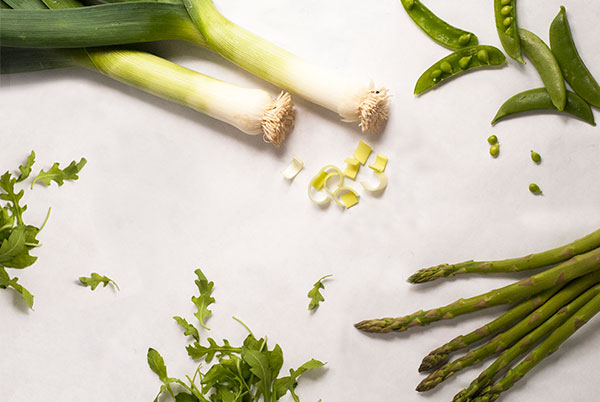
Spring Super Foods
Arugula
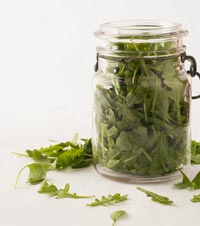
Although it is a leafy green, arugula (also called rocket) is classified as a cruciferous vegetable, joining the ranks of broccoli, cauliflower, and cabbage. Cruciferous vegetables are known for their beneficial glucosinolates, compounds that appear very useful in protecting against cancer. Arugula is a silent super food often overlooked in the produce section and overshadowed by all-stars like kale and chard. But with its impressive nutritional profile of vitamins A, C, K, iron, calcium, and antioxidants like lutein and zeaxanthin, arugula definitely deserves a prominent place in the refrigerator.
Store arugula in a loose plastic bag in the refrigerator for 2-4 days. Wash and dry with a salad spinner just before using.
Savor Arugula:
Lemon brightens the flavor of arugula. For a refreshing salad, make a dressing with 1 part freshly squeezed lemon juice to 2 parts olive oil. Add ½ teaspoon kosher salt and ¼ teaspoon freshly ground pepper for every ½ cup of olive oil. Toss with arugula and shavings of Parmesan.
Asparagus
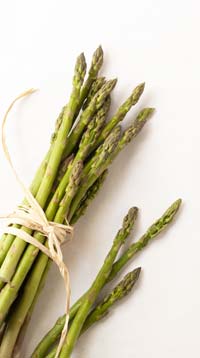
Chock-full of nutrients, this springtime stalk provides a hefty dose of anti-inflammatory action with its abundance of vitamin C, beta-carotene, vitamin E, zinc, and more. Anti-inflammatory foods are some of the best known fighters of diseases including diabetes, heart disease, and various types of cancer. Asparagus also contains a unique type of carbohydrate called inulin, which is often referred to in the medical community as a prebiotic. As they pass through the digestive tract, prebiotics feed the gut’s good bacteria (probiotics) and therefore support the immune system and colonization of healthy gut flora.Choose asparagus stalks that are uniform in thickness, avoiding very thick stalks as they can be woody. To store asparagus, wrap a damp paper towel around the bottom of the stalks. Place in a loose plastic bag or airtight container and refrigerate in the crisper for 2-4 days.
Savor Asparagus:
To roast asparagus, trim off the woody ends and lightly peel the stalks. Place on a baking sheet and drizzle with a little olive oil. Add a pinch of salt and pepper. Roast at 425ºF for 10-15 minutes. If desired, sprinkle a handful of grated Parmesan on top during the last 2-3 minutes of roasting.
Leeks
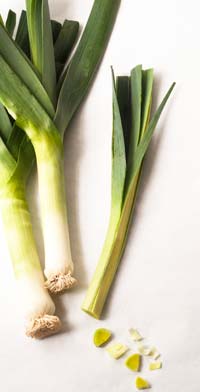
Like their cousins onions and garlic, leeks belong to the allium family of vegetables. Although leeks are less researched than other allium vegetables, they contain many similar sulfur compounds that are well-known antioxidants. These sulfur compounds also aid in the body’s detox systems, making leeks an excellent choice for “spring cleaning” the organs and energy pathways in the body. To increase the availability of the beneficial nutrients in leeks, allow them to sit for 5-10 minutes after chopping.Choose leeks that are firm with white bases and dark green tops. Avoid yellowed leaves or bruised bulbs. Store leeks wrapped in a loose plastic bag in the refrigerator for 1-2 weeks.
Savor Leeks:
For a sophisticated and unique side dish, try braised leeks. Cut off the root end and green part of the leeks. Cut in half lengthwise and rinse to remove any dirt. Sauté in a little butter or olive oil for a few minutes on each side. Add ½ cup or so of chicken or vegetable stock, cover the pan, and simmer for 10 minutes or until the leeks are tender. Season with a bit of salt and pepper.
Peas
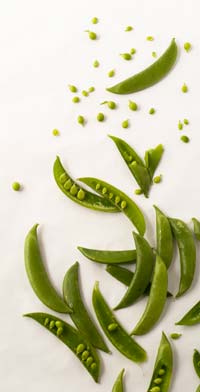
A longtime staple in the diets of foodies young and old, peas deserve a second glance. Considered a legume, peas offer a substantial amount of plant-based protein and fiber, both of which help to regulate the pace of digestion and therefore support balanced blood sugar levels. While not always recognized as a phytonutrients- rich food, peas actually offer quite the spectrum of immune-boosting substances like vitamins C and K, energizing B vitamins, and muscle- supporting zinc and magnesium.
Store snap peas (whole pod) in a loose plastic bag or airtight container in the refrigerator for 3-5 days. Shelled peas can be stored in the same manner for up to 1 week. Frozen peas should be used within 2-3 months.
Savor Peas:
Make a quick minted pea soup by sautéing 3 leeks (white parts only) or a small onion in 2 tablespoons olive oil or butter until soft. Add 1 (14-ounce) bag of frozen peas and 4 cups chicken or vegetable stock. Gently simmer for 3 minutes or until the peas are defrosted. Transfer to a blender and process with ½ cup fresh mint leaves and a big pinch of salt and pepper. Serve hot or chilled with a dollop of sour cream or yogurt if desired.




Pingback: Gluten Free Glazed Chicken and Peach Skewers Recipe | Simply Gluten Free
Pingback: Thai-style Asparagus | Recipes | Simply Gluten Free
Pingback: Grilled Vegetable Salad | Gluten Free Recipes | Blog
Pingback: Gluten Free Superfood Pasta | Recipe